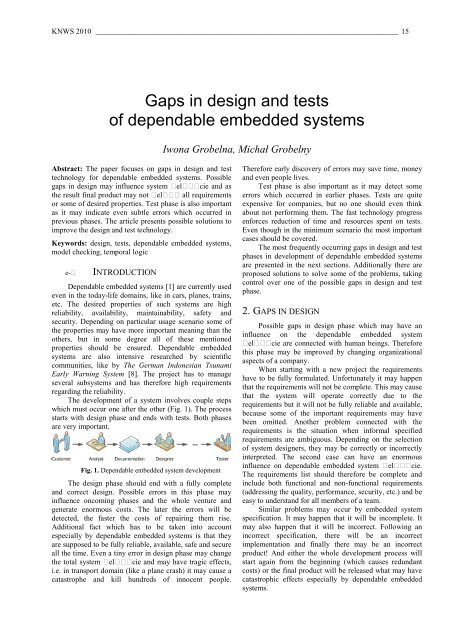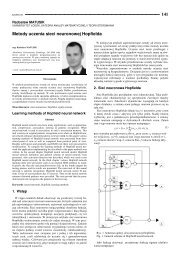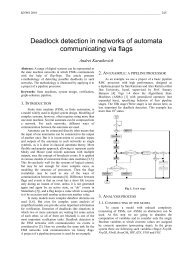Gaps in design and tests of dependable embedded systems
Gaps in design and tests of dependable embedded systems
Gaps in design and tests of dependable embedded systems
You also want an ePaper? Increase the reach of your titles
YUMPU automatically turns print PDFs into web optimized ePapers that Google loves.
KNWS 2010 _______________________________________________________________________________ 15<br />
<strong>Gaps</strong> <strong>in</strong> <strong>design</strong> <strong>and</strong> <strong>tests</strong><br />
<strong>of</strong> <strong>dependable</strong> <strong>embedded</strong> <strong>systems</strong><br />
Iwona Grobelna, Michał Grobelny<br />
Abstract: The paper focuses on gaps <strong>in</strong> <strong>design</strong> <strong>and</strong> test<br />
technology for <strong>dependable</strong> <strong>embedded</strong> <strong>systems</strong>. Possible<br />
gaps <strong>in</strong> <strong>design</strong> may <strong>in</strong>fluence system elcie <strong>and</strong> as<br />
the result f<strong>in</strong>al product may not el all requirements<br />
or some <strong>of</strong> desired properties. Test phase is also important<br />
as it may <strong>in</strong>dicate even subtle errors which occurred <strong>in</strong><br />
previous phases. The article presents possible solutions to<br />
improve the <strong>design</strong> <strong>and</strong> test technology.<br />
Keywords: <strong>design</strong>, <strong>tests</strong>, <strong>dependable</strong> <strong>embedded</strong> <strong>systems</strong>,<br />
model check<strong>in</strong>g, temporal logic<br />
e-<br />
INTRODUCTION<br />
Dependable <strong>embedded</strong> <strong>systems</strong> [1] are currently used<br />
even <strong>in</strong> the today-life doma<strong>in</strong>s, like <strong>in</strong> cars, planes, tra<strong>in</strong>s,<br />
etc. The desired properties <strong>of</strong> such <strong>systems</strong> are high<br />
reliability, availability, ma<strong>in</strong>ta<strong>in</strong>ability, safety <strong>and</strong><br />
security. Depend<strong>in</strong>g on particular usage scenario some <strong>of</strong><br />
the properties may have more important mean<strong>in</strong>g than the<br />
others, but <strong>in</strong> some degree all <strong>of</strong> these mentioned<br />
properties should be ensured. Dependable <strong>embedded</strong><br />
<strong>systems</strong> are also <strong>in</strong>tensive researched by scientific<br />
communities, like by The German Indonesian Tsunami<br />
Early Warn<strong>in</strong>g System [8]. The project has to manage<br />
several sub<strong>systems</strong> <strong>and</strong> has therefore high requirements<br />
regard<strong>in</strong>g the reliability.<br />
The development <strong>of</strong> a system <strong>in</strong>volves couple steps<br />
which must occur one after the other (Fig. 1). The process<br />
starts with <strong>design</strong> phase <strong>and</strong> ends with <strong>tests</strong>. Both phases<br />
are very important.<br />
Fig. 1. Dependable <strong>embedded</strong> system development<br />
The <strong>design</strong> phase should end with a fully complete<br />
<strong>and</strong> correct <strong>design</strong>. Possible errors <strong>in</strong> this phase may<br />
<strong>in</strong>fluence oncom<strong>in</strong>g phases <strong>and</strong> the whole venture <strong>and</strong><br />
generate enormous costs. The later the errors will be<br />
detected, the faster the costs <strong>of</strong> repair<strong>in</strong>g them rise.<br />
Additional fact which has to be taken <strong>in</strong>to account<br />
especially by <strong>dependable</strong> <strong>embedded</strong> <strong>systems</strong> is that they<br />
are supposed to be fully reliable, available, safe <strong>and</strong> secure<br />
all the time. Even a t<strong>in</strong>y error <strong>in</strong> <strong>design</strong> phase may change<br />
the total system elcie <strong>and</strong> may have tragic effects,<br />
i.e. <strong>in</strong> transport doma<strong>in</strong> (like a plane crash) it may cause a<br />
catastrophe <strong>and</strong> kill hundreds <strong>of</strong> <strong>in</strong>nocent people.<br />
Therefore early discovery <strong>of</strong> errors may save time, money<br />
<strong>and</strong> even people lives.<br />
Test phase is also important as it may detect some<br />
errors which occurred <strong>in</strong> earlier phases. Tests are quite<br />
expensive for companies, but no one should even th<strong>in</strong>k<br />
about not perform<strong>in</strong>g them. The fast technology progress<br />
enforces reduction <strong>of</strong> time <strong>and</strong> resources spent on <strong>tests</strong>.<br />
Even though <strong>in</strong> the m<strong>in</strong>imum scenario the most important<br />
cases should be covered.<br />
The most frequently occurr<strong>in</strong>g gaps <strong>in</strong> <strong>design</strong> <strong>and</strong> test<br />
phases <strong>in</strong> development <strong>of</strong> <strong>dependable</strong> <strong>embedded</strong> <strong>systems</strong><br />
are presented <strong>in</strong> the next sections. Additionally there are<br />
proposed solutions to solve some <strong>of</strong> the problems, tak<strong>in</strong>g<br />
control over one <strong>of</strong> the possible gaps <strong>in</strong> <strong>design</strong> <strong>and</strong> test<br />
phase.<br />
2. GAPS IN DESIGN<br />
Possible gaps <strong>in</strong> <strong>design</strong> phase which may have an<br />
<strong>in</strong>fluence on the <strong>dependable</strong> <strong>embedded</strong> system<br />
elcie are connected with human be<strong>in</strong>gs. Therefore<br />
this phase may be improved by chang<strong>in</strong>g organizational<br />
aspects <strong>of</strong> a company.<br />
When start<strong>in</strong>g with a new project the requirements<br />
have to be fully formulated. Unfortunately it may happen<br />
that the requirements will not be complete. This may cause<br />
that the system will operate correctly due to the<br />
requirements but it will not be fully reliable <strong>and</strong> available,<br />
because some <strong>of</strong> the important requirements may have<br />
been omitted. Another problem connected with the<br />
requirements is the situation when <strong>in</strong>formal specified<br />
requirements are ambiguous. Depend<strong>in</strong>g on the selection<br />
<strong>of</strong> system <strong>design</strong>ers, they may be correctly or <strong>in</strong>correctly<br />
<strong>in</strong>terpreted. The second case can have an enormous<br />
<strong>in</strong>fluence on <strong>dependable</strong> <strong>embedded</strong> system elcie.<br />
The requirements list should therefore be complete <strong>and</strong><br />
<strong>in</strong>clude both functional <strong>and</strong> non-functional requirements<br />
(address<strong>in</strong>g the quality, performance, security, etc.) <strong>and</strong> be<br />
easy to underst<strong>and</strong> for all members <strong>of</strong> a team.<br />
Similar problems may occur by <strong>embedded</strong> system<br />
specification. It may happen that it will be <strong>in</strong>complete. It<br />
may also happen that it will be <strong>in</strong>correct. Follow<strong>in</strong>g an<br />
<strong>in</strong>correct specification, there will be an <strong>in</strong>correct<br />
implementation <strong>and</strong> f<strong>in</strong>ally there may be an <strong>in</strong>correct<br />
product! And either the whole development process will<br />
start aga<strong>in</strong> from the beg<strong>in</strong>n<strong>in</strong>g (which causes redundant<br />
costs) or the f<strong>in</strong>al product will be released what may have<br />
catastrophic effects especially by <strong>dependable</strong> <strong>embedded</strong><br />
<strong>systems</strong>.
16 _______________________________________________________________________________ KNWS 2010<br />
Another problem is connected with the<br />
documentation. It is well known that a project should be<br />
fully documented. Lack <strong>of</strong> documentation may cause the<br />
overseen <strong>of</strong> some organizational <strong>and</strong> technical aspects or<br />
that the development process will last for a long period <strong>of</strong><br />
time due to these lacks. But even if the documentation is<br />
prepared carefully by all team members, it should be<br />
ensured that there is a correct <strong>and</strong> complete flow <strong>of</strong><br />
documentation. Documentation should be correctly<br />
distributed <strong>in</strong> the team, i.e. if a complete documentation is<br />
kept by its owner or is delivered not to the <strong>in</strong>terested team<br />
members but only to some part <strong>of</strong> the team which does not<br />
need it, is just useless.<br />
2.1. POSSIBLE SOLUTION: MODEL CHECKING<br />
FOR FORMAL VERIFICATION OF SPECIFICATION<br />
Errors <strong>in</strong> the specification can be detected us<strong>in</strong>g<br />
formal verification methods [2] [5]. They can be used<br />
when the real system does not physically exist yet,<br />
prevent<strong>in</strong>g from possible errors on an early stage <strong>of</strong><br />
system development. One <strong>of</strong> them is Model Check<strong>in</strong>g [3]<br />
which will be further presented, not forgett<strong>in</strong>g about<br />
Theorem Prov<strong>in</strong>g [5] as another formal verification<br />
method with all its advantages <strong>and</strong> disadvantages. Model<br />
check<strong>in</strong>g allows fully automated system verification <strong>and</strong><br />
error detection <strong>in</strong> elciee system specification by<br />
computer deduction tools (model checkers). The technique<br />
can be used to verify the whole system or just some part <strong>of</strong><br />
it (partial verification). It is especially valuable by large<br />
<strong>systems</strong> where the <strong>design</strong> process lasts for a long period <strong>of</strong><br />
time <strong>and</strong> is a complex <strong>and</strong> difficult task. Then the<br />
verification can be performed step-by-step dur<strong>in</strong>g the<br />
<strong>design</strong> phase, each time consider<strong>in</strong>g only a subset <strong>of</strong><br />
requirements.<br />
It is important to remember that model check<strong>in</strong>g can<br />
not prove that the system model is completely correct. It<br />
can just prove that the model does or does not satisfy<br />
specified requirements.<br />
It verifies whether the requirements are satisfied <strong>in</strong><br />
def<strong>in</strong>ed system model. User has to formally specify<br />
requirements for the <strong>embedded</strong> system. It is also needed to<br />
model the system us<strong>in</strong>g description language <strong>of</strong> a chosen<br />
model checker. Computer deduction tool automatically<br />
verifies the system <strong>and</strong> gives an answer whether the model<br />
satisfies the specification or not (model check<strong>in</strong>g<br />
technique is schematically presented <strong>in</strong> Fig. 2). If not –<br />
some errors must have been detected <strong>and</strong> appropriate<br />
counterexamples are generated.<br />
Fig. 2. Model check<strong>in</strong>g technique<br />
Discussed formal verification method can <strong>in</strong>dicate<br />
some errors either <strong>in</strong> requirements specification or <strong>in</strong><br />
model description. In the first situation some requirements<br />
may have been <strong>in</strong>correctly formulated. In the second<br />
situation the system <strong>design</strong> itself may be <strong>in</strong>correct. System<br />
<strong>design</strong>er has to carefully analyze received<br />
counterexamples, f<strong>in</strong>d the source <strong>of</strong> an error <strong>and</strong> solve the<br />
problem either by chang<strong>in</strong>g system model or the<br />
requirements list. Without human <strong>in</strong>teraction the received<br />
results do not localize the problem, they just mention that<br />
there is a problem.<br />
Required properties <strong>of</strong> <strong>dependable</strong> <strong>embedded</strong> system<br />
are def<strong>in</strong>ed us<strong>in</strong>g temporal logic [4] formulas. They are<br />
coded us<strong>in</strong>g the specification language <strong>of</strong> a chosen model<br />
checker. User has to specify as many desired properties as<br />
possible. This is due to the fact that only the def<strong>in</strong>ed<br />
properties will be checked.<br />
2.2. A LITTLE BACKGROUND ON TEMPORAL LOGIC<br />
Temporal logic [4] [6] [7] derives from modal logic<br />
<strong>and</strong> was <strong>in</strong>troduced <strong>in</strong>to comput<strong>in</strong>g science by Amir<br />
Pnuelli <strong>in</strong> 1977 when he proposed to use temporal logic <strong>in</strong><br />
concurrent <strong>and</strong> re-active <strong>systems</strong>. Nowadays it is used as<br />
well <strong>in</strong> program specification as <strong>in</strong> its verification,<br />
synthesis <strong>and</strong> even logical programm<strong>in</strong>g. Us<strong>in</strong>g temporal<br />
logic <strong>and</strong> its operators it is possible to formally specify<br />
<strong>embedded</strong> system functionality.<br />
L<strong>in</strong>ear Temporal Logic (LTL) is a classical temporal<br />
logic <strong>and</strong> describes relations <strong>in</strong> the system specify<strong>in</strong>g state<br />
sequences. In some states a given formula can be satisfied,<br />
while it can not be satisfied <strong>in</strong> the others. Basic temporal<br />
logic operators with their mean<strong>in</strong>gs <strong>and</strong> examples are<br />
listed <strong>in</strong> Table 1.<br />
Table 1.<br />
Basic temporal logic operators<br />
Sign Mean<strong>in</strong>g Example Explanation<br />
always p p is true <strong>in</strong> all<br />
states<br />
◊ sometimes ◊ p p is true <strong>in</strong><br />
some states<br />
o next o p p is true <strong>in</strong> the<br />
next state<br />
Temporal logic with time branches is Computation<br />
Tree Logic (CTL). Time is here presented as a tree<br />
branch<strong>in</strong>g out <strong>in</strong>to the future with present moment as the<br />
root. Basic temporal connectors are presented <strong>in</strong> Table 2.<br />
Table 2.<br />
Temporal connectors<br />
Quantifier Explanation<br />
Path quantifiers<br />
E<br />
for some path<br />
A<br />
for all paths<br />
State quantifiers<br />
F<br />
for some state<br />
G<br />
for all states<br />
Path quantifiers are characteristic for branch<strong>in</strong>g time<br />
temporal logic <strong>and</strong> are meant for paths beg<strong>in</strong>n<strong>in</strong>g from a<br />
given state. State quantifiers are for states <strong>in</strong> that path.<br />
Comb<strong>in</strong><strong>in</strong>g path <strong>and</strong> state quantifiers it is possible to<br />
describe complex dependencies, like for example:<br />
Afp — In every path there is some state where<br />
formula p is true
KNWS 2010 _______________________________________________________________________________ 17<br />
Efp — In some path there is some state where<br />
formula p is true<br />
Agp — In every path <strong>in</strong> every state formula p is<br />
true<br />
Egp — In some path <strong>in</strong> every state formula p is<br />
true<br />
Model check<strong>in</strong>g technique uses temporal logic <strong>and</strong><br />
allows to formally verify specifications <strong>of</strong> <strong>dependable</strong><br />
<strong>embedded</strong> <strong>systems</strong>.<br />
3. GAPS IN TESTS<br />
Test phase should f<strong>in</strong>d all exist<strong>in</strong>g errors so that the<br />
f<strong>in</strong>al product is as much reliable as possible. However it is<br />
a difficult task. Embedded <strong>systems</strong> require huge amount <strong>of</strong><br />
rigorous <strong>tests</strong> which ensure appropriate quality [9]. The<br />
ma<strong>in</strong> problem is the fact that exhaust<strong>in</strong>g test<strong>in</strong>g is <strong>of</strong>ten<br />
impossible. There are white-box (structural), black-box<br />
(functional), module, <strong>and</strong> <strong>in</strong>tegration <strong>tests</strong> necessary to<br />
prove that <strong>design</strong>ed product elc previously<br />
assumed requirements. It may not be possible to check all<br />
configurations <strong>of</strong> <strong>in</strong>put data with all configurations <strong>of</strong> the<br />
parameters <strong>of</strong> the surround<strong>in</strong>g environment. This <strong>in</strong>dicates<br />
possible gaps <strong>in</strong> the test phase which may cause that some<br />
errors which could be h<strong>and</strong>led will not be found.<br />
One <strong>of</strong> them is the situation where <strong>tests</strong> do not cover<br />
all important fields <strong>and</strong> technical aspects. Often tester<br />
concentrates on particular field <strong>of</strong> <strong>dependable</strong> <strong>embedded</strong><br />
system usage <strong>and</strong> does not foresee that someth<strong>in</strong>g other<br />
can happen. Tester teams should <strong>in</strong>clude <strong>in</strong>novative <strong>and</strong><br />
creative testers which foresee even the so-called notpossible-to-happen-situations.<br />
This is especially important<br />
by <strong>embedded</strong> <strong>systems</strong> which have to be fully reliable [9].<br />
Test quality depends though on the appropriate selection<br />
<strong>of</strong> test cases.<br />
In many <strong>in</strong>dustrial projects prototypes are tested<br />
either by <strong>design</strong>ers or eng<strong>in</strong>eers strongly connected with<br />
particular project. Frequent reason is cost m<strong>in</strong>imization<br />
<strong>and</strong> short development time. Nowadays the very fast<br />
evolution <strong>of</strong> technology enforces short term <strong>of</strong> products<br />
<strong>design</strong> <strong>and</strong> development. Time is <strong>of</strong>ten to short to<br />
el all test cases. To reduce the test time companies<br />
may assign <strong>design</strong>ers to test<strong>in</strong>g phase. It has the<br />
economical advantages that they already know the product<br />
<strong>and</strong> its desired functionality, so that they do not waste time<br />
on gett<strong>in</strong>g to know the documentation. However <strong>in</strong> many<br />
situations <strong>design</strong>ers are confident or just assume that<br />
someth<strong>in</strong>g operates correctly <strong>and</strong> do not concentrate on<br />
obvious system properties. Unfortunately, even <strong>in</strong> obvious<br />
properties there may be a t<strong>in</strong>y problem which would be<br />
easy found dur<strong>in</strong>g a simple test, but someone has to<br />
perform it.<br />
Not only manual functional test<strong>in</strong>g is taken <strong>in</strong>to<br />
account. Automated test<strong>in</strong>g plays a strong role <strong>in</strong> latest<br />
projects. Considered are here s<strong>of</strong>tware as well as hardware<br />
<strong>tests</strong>. In test environment an appropriate preparation <strong>of</strong><br />
such procedure is even more important. Let us assume that<br />
there is an error <strong>in</strong> test procedure, which omits one <strong>of</strong> key<br />
system properties / features. Such test can false ensure the<br />
system quality which can have tragic results. Therefore the<br />
<strong>design</strong> <strong>of</strong> test environment <strong>and</strong> automated test procedures<br />
must be prepared even more carefully than tested system.<br />
That means that sometimes test procedure preparation can<br />
last longer than the product <strong>design</strong> phase. Moreover, the<br />
cost <strong>of</strong> <strong>tests</strong> can highly <strong>in</strong>crease. Here appears a possible<br />
huge gap. Currently cost reductions are popular, <strong>and</strong><br />
follow<strong>in</strong>g further with such reason<strong>in</strong>g, the reduction <strong>of</strong> test<br />
costs is considered. Therefore nowadays there is a trend <strong>in</strong><br />
turn<strong>in</strong>g end-user <strong>in</strong>to a tester which ends with purchas<strong>in</strong>g<br />
partly tested products to the market.<br />
3.1. POSSIBLE SOLUTION: INDEPENDENT TESTER<br />
TEAMS<br />
Dependable <strong>embedded</strong> <strong>systems</strong> should be carefully<br />
tested so that as many errors as possible are found. The<br />
dreamed test phase <strong>in</strong>dicates all errors, but <strong>in</strong> reality some<br />
<strong>of</strong> them may be easily overseen. Test<strong>in</strong>g phase should<br />
<strong>in</strong>volve additionally <strong>in</strong>dependent tester teams (Fig. 3) –<br />
one team with eng<strong>in</strong>eers <strong>and</strong> the second with future<br />
ord<strong>in</strong>ary users.<br />
Fig. 3. Proposed tester teams<br />
Eng<strong>in</strong>eers underst<strong>and</strong> how everyth<strong>in</strong>g operates <strong>and</strong><br />
may concentrate on more technical aspects, like i.e.<br />
representation <strong>of</strong> data or imperfect r<strong>and</strong>omness. It is<br />
important that no one <strong>of</strong> tester team took part <strong>in</strong> product<br />
<strong>design</strong> or development. Then they have fresh look <strong>and</strong><br />
may spend much energy on test<strong>in</strong>g.<br />
Product prototypes should also be tested by ord<strong>in</strong>ary<br />
users who the product is addressed to. They concentrate on<br />
its functionality <strong>and</strong> test both the desired properties <strong>and</strong><br />
the situations <strong>of</strong>ten not taken <strong>in</strong>to consideration by<br />
eng<strong>in</strong>eers. They may i.e. push multiple times the same<br />
button or the same comb<strong>in</strong>ation <strong>of</strong> buttons to force some<br />
reaction <strong>of</strong> <strong>dependable</strong> <strong>embedded</strong> system. Sometimes it is<br />
based on lack <strong>of</strong> experience <strong>in</strong> us<strong>in</strong>g the device. Such<br />
elcie can help <strong>in</strong> discover<strong>in</strong>g bugs <strong>of</strong> the device<br />
caused by not foreseen user elcie or <strong>in</strong>valid data<br />
<strong>in</strong>put. Designer who is test<strong>in</strong>g self-made device <strong>of</strong>ten can<br />
not know all possible elcie <strong>of</strong> an not experienced<br />
simple end-user. Therefore some part <strong>of</strong> test has to be<br />
realized with testers outside <strong>of</strong> a project.<br />
4. CONCLUSION<br />
As shortly presented <strong>in</strong> the previous sections the<br />
<strong>design</strong> <strong>and</strong> test technology <strong>of</strong> <strong>dependable</strong> <strong>embedded</strong><br />
<strong>systems</strong> <strong>in</strong>volve many traps <strong>and</strong> there are numerous places<br />
where someth<strong>in</strong>g can go wrong.<br />
Human be<strong>in</strong>g is always a possible gap <strong>in</strong> <strong>design</strong> <strong>and</strong><br />
test technology. Both phases can not be performed without<br />
people but this fact makes it also possible to control the
18 _______________________________________________________________________________ KNWS 2010<br />
gaps. People <strong>in</strong>volved <strong>in</strong> the <strong>dependable</strong> <strong>embedded</strong> system<br />
development should consider potential possible situations<br />
<strong>and</strong> th<strong>in</strong>k one more time, before they do anyth<strong>in</strong>g. The<br />
technology itself can not provide high product quality, it<br />
can support it, but <strong>in</strong>telligent human <strong>in</strong>teraction is here<br />
always needed.<br />
There exists an assumption that there is no technical<br />
system which is 100% reliable <strong>and</strong> which has no errors.<br />
However, the number <strong>of</strong> them should be m<strong>in</strong>imized so that<br />
the reliability, availability <strong>and</strong> ma<strong>in</strong>ta<strong>in</strong>ability rises. Faulttolerant<br />
<strong>systems</strong> have such advantage that they can try to<br />
keep the reliability <strong>of</strong> computation even <strong>in</strong> the presence <strong>of</strong><br />
faults. This is achieved ma<strong>in</strong>ly by redundancy <strong>of</strong> data,<br />
<strong>in</strong>structions, s<strong>of</strong>tware, hardware <strong>and</strong> time. Dependable<br />
<strong>embedded</strong> system should operate correctly over time, <strong>and</strong><br />
even if it is not hundred percent correct or some<br />
unpredicted circumstances occur then the potential effect<br />
<strong>of</strong> a failure should be avoided or just m<strong>in</strong>imized.<br />
mgr <strong>in</strong>ż. Iwona Grobelna<br />
Uniwersytet Zielonogórski<br />
Wydział Elektrotechniki, Informatyki i<br />
Telekomunikacji<br />
Instytut Informatyki i Elektroniki<br />
ul. Podgórna 50<br />
65-246 Zielona Góra<br />
e-mail: i.grobelna@iie.uz.zgora.pl<br />
mgr <strong>in</strong>ż. Michał Grobelny<br />
Uniwersytet Zielonogórski<br />
Wydział Elektrotechniki, Informatyki i<br />
Telekomunikacji<br />
ul. Podgórna 50<br />
65-246 Zielona Góra<br />
e-mail: m.grobelny@weit.uz.zgora.pl<br />
REFERENCES<br />
[1] A. Avizienis, J. Laprie, <strong>and</strong> B. R<strong>and</strong>ell, Fundamental<br />
Concepts <strong>of</strong> Computer System Dependability,<br />
IARP/IEEE-RAS Workshop on Robot<br />
Dependability: Technological Challenge <strong>of</strong><br />
Dependable Robots <strong>in</strong> Human Environments, Seoul,<br />
Korea, May 2001<br />
[2] E.M. Clarke, J.M. W<strong>in</strong>g et al., Formal methods: State<br />
<strong>of</strong> the Art <strong>and</strong> Future Directions, ACM Comput<strong>in</strong>g<br />
Surveys, Vol. 28, No. 4, 1996<br />
[3] E.A. Emerson, The Beg<strong>in</strong>n<strong>in</strong>g <strong>of</strong> Model Check<strong>in</strong>g:<br />
A Personal Perspective, Lecture Notes <strong>in</strong> Computer<br />
Science, 25 Years <strong>of</strong> Model Check<strong>in</strong>g: History,<br />
Achievements, Perspectives, 2008, pp. 27 – 45<br />
[4] M. Huth, M. Ryan, Logic <strong>in</strong> Computer Science.<br />
Modell<strong>in</strong>g <strong>and</strong> Reason<strong>in</strong>g about Systems, Cambridge<br />
University Press 2004<br />
[5] C. Kern, M.R. Greenstreet, Formal Verification<br />
<strong>in</strong> Hardware Design: A Survey, ACM Transactions<br />
on Design Automation <strong>of</strong> Electronic Systems<br />
(TODAES), Vol. 4, Issue 2, April 1999,<br />
pp. 123 – 193<br />
[6] L. Lamport, “Sometime” is sometimes “not never”,<br />
On the Temporal Logic <strong>of</strong> Programs, Proceed<strong>in</strong>gs<br />
<strong>of</strong> the Seventh ACM Symposium on Pr<strong>in</strong>ciples<br />
<strong>of</strong> Programm<strong>in</strong>g Languages, ACM SIGACT-<br />
SIGPLAN 1980, pp. 174 – 185<br />
[7] M.V. Rice, M.Y. Vardi, Branch<strong>in</strong>g vs. L<strong>in</strong>ear Time:<br />
F<strong>in</strong>al Showdown, Proceed<strong>in</strong>gs <strong>of</strong> the 2001<br />
Conference on Tools <strong>and</strong> Algorithms for the<br />
Construction <strong>and</strong> Analysis <strong>of</strong> Systems, TACAS<br />
2001, LNCS Volume 2031, Spr<strong>in</strong>ger-Verlag 2001,<br />
pp. 1 – 22<br />
[8] B.Schnor, Dependable <strong>and</strong> Fault Tolerant Distributed<br />
Systems, DAAD-DEDIS Summer Academy, Cottbus<br />
5.9.2008<br />
[9] Wei-Tek Tsai, Lian Yu, Feng Zhu, Paul, R., Rapid<br />
<strong>embedded</strong> system test<strong>in</strong>g us<strong>in</strong>g verification patterns,<br />
S<strong>of</strong>tware, IEEE Volume 22, Issue 4, July-Aug. 2005<br />
pp. 68 – 75






